Apple variety Sinap Orlovsky
Sinap Orlovsky is a late winter apple variety obtained in 1955 at the All-Russian Research Institute for Breeding Fruit Crops and the All-Union Research Institute of Horticulture named after V.I. I. V. Michurina as a result of crossing of two well-known varietal apple trees - North synap and Memory of Michurin. The authors of this variety are domestic breeders: Sedov E.N., Trofimova T.A., Zaets V.K. and Krasova N.G.
For the State test, Sinap Orlovsky was accepted in 1979, and 10 years later it was zoned in the Central, Central Black Earth, Middle Volga and North-Western regions of our country, as well as in six regions of Belarus. The most widespread apple tree received in central Russia, and not only in private gardens, but also in industrial gardens.
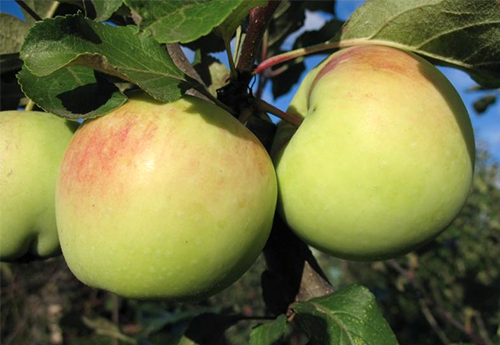
Trees of this variety are large in size, therefore, when laying a plot for them, you need to allocate a lot of free space. Apple trees have a wide crown and rather massive spreading branches. Due to the sparse arrangement of the main branches, the crown does not become too dense, which undoubtedly makes it easier to care for the tree and contributes to the collection of a high-quality crop. However, trees need periodic pruning and shaping. This apple tree is characterized by the departure of the main branches from the trunk at a right angle, while the ends of the branches are directed upward. The surface of the bark on the trunk and skeletal branches is rough and gray in color.
Shoots are dark brown, of medium thickness, strongly pubescent, geniculate, with sparsely arranged leaves, faceted in cross section. Lentils are few and small in size. The buds are large, pubescent, appressed, conical in shape. Sinap Orlovsky is characterized by a mixed type of fruiting: on simple and complex ringlets, short and long fruit twigs. Leaves are large, wide, dark green in color, pubescent, obovate, almost flat, with a pointed base, broadly wedge-shaped. The surface of the leaves can be flat or convex. On the edge, the leaf is wavy, serrate-crenate, crenate at the base. The tips of the leaves are twisted, the edges are raised. The petioles are short, the stipules are large, lanceolate, about the same length as the petioles. A significant part of the leaves on the shoot drooping, departing at an obtuse angle to the shoot.
In the spring, the trees of this variety become the main decoration of the garden due to the large flowers of a delicate light pink color. The buds have a white-pink tint, the petals are closed, the stigma of the pistil is more often located below the anthers, much less often - at the same level with them.
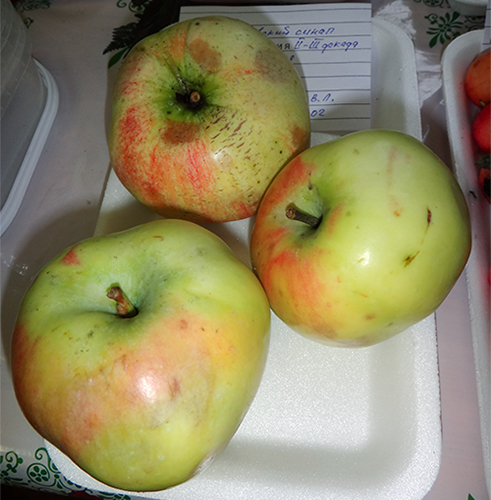
The fruits of the Sinap Orlovsky apple tree grow in most of them of a fairly large size or clearly more than average (the weight of one apple is on average 150 grams). All apples are of the same size, rounded-conical, oblong, with a slightly sloping top and blunt ribs. The skin on the fruits is dense, the surface is glossy, smooth, with a slight oily sheen. On the peel of an apple, you can easily see large white subcutaneous dots. During the harvesting period, the main color of the fruit is yellowish-green, after a short storage it becomes golden-yellow. The cover color of apples is noticeable only from their sunny side in the form of a delicate, blurred blush. The funnel has a narrow, sharp-conical shape, there is no rustiness. The peduncle can be short or medium in length. Fruits with a deep saucer bordered by ribs are rather large in size. In most cases the calyx is closed in apples, but in large fruits it can be open or half-open. The heart is weak.The seed chambers can be open or closed. Seeds are brown in color, small, pointed, ribbed. The sub-cup tube is small and conical in shape.
The pulp of apples has excellent taste due to the harmonious combination of acidity and sweetness, juiciness and delicate, pleasant aroma. By its structure, the pulp is loose, prone to splitting, greenish-creamy color. The average long-term assessment of the taste of fruits on the tasting scale is 4.4 - 4.7 points. The assessment of the appearance of apples is 4.3 points. By chemical composition, the fruits contain: sugars (9.5%), titratable acid (0.52%), pectin substances (8.9%), ascorbic acid (13.7 mg / 100 g), P-active substances (194 mg / 100 g).

The period of removable ripeness of fruits in the middle lane falls on the last days of September. The apples of this variety have a very high maturation ability, the fruits are preserved until the end of spring. This quality is very attractive for commercial cultivation: apples are used by manufacturers of baby food and juices.
The trees of Sinap Orlovsky have high rates of winter hardiness and early maturity. Medium scab resistance was noted. Young trees grow quite actively, fruiting begins at 4 - 5 years. Unlike Antonovka trees of this variety bear fruit steadily every year, and not only young apple trees, but also adults. According to VNIISPK, up to 170 centners of the crop can be obtained from 1 hectare of orchard. The best pollinators for this variety are Antonovka vulgaris and Welsey.
The obvious advantages of the Sinap Orlovsky apple tree are high consumer and commercial qualities of apples, early maturity, long-term storage of fruits intact, a good level of winter hardiness.
The main disadvantage is the large size of the trees.
Despite the simplicity of care, it is advisable to choose fertile soil for planting Sinap Orlovsky. With a low level of calcium in the soil, the fruits are affected by diseases and the taste of apples becomes not entirely pleasant (bitter pitting appears).
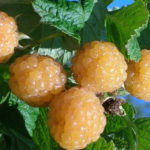
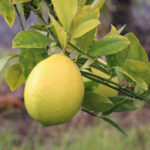
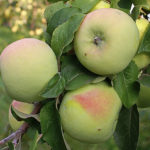
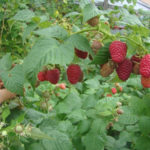
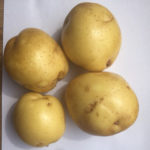
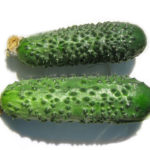



Four years ago, Bogatyr Antonovka and Sinap Orlovsky planted apple trees ... 2 years in a row Antonovka has been producing crops, and Sinap Orlovsky did not even grow, as it were, in a dormant state. What's the matter?
Same. Does not grow, does not bear fruit. 10 years. I bought it in the nursery named after Michurin from Tambov.
Two options are most likely: 1) deeply buried during landing 2) ran into the GPZ zone.
Please tell me what is a GPZ zone?
Probably, it meant the close occurrence of groundwater.
My tree is 34 years old. Bears fruit annually. The yield is very high. The apples are large, up to 320 grams. There are no small ones. Stored until May 9, it happened, they ate fresh in June. They did not suffer from the scab even this year. He is not afraid of frost and thaws. Frostbite no. The branches are powerful, sparse, do not break. It tastes better yet - among late winter. Grafted on Antonovka seedling. Reached a height of 18 meters. I will make a reduction, although the first 15 years may not be cut off. We remove the fruits after frost, October 10 - 25.
At 62−396 it grew about 2.5 meters, the yields are not impressive and the fruits on the dwarf are smaller (I feed, mulch, water). Roots are weak.
Oryol synap is good for everyone, but very vigorous.Plant on URAL 5.
The hero bears fruit in a year.
Nikolay, I agree that the OS tastes great, the pulp is dense, juicy, grainy. The apples are luxurious, large, at a young age, green with a yellow barrel, but for two years now the barrel has been turning red.